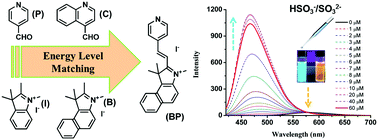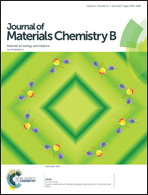A series of water-soluble A–π–A′ typological indolium derivatives with two-photon properties for rapidly detecting HSO3−/SO32− in living cells†
Abstract
It is believed that HSO3− and SO32− play important roles in several physiological processes. However, probes with two-photon absorption to detect HSO3− or SO32− in living cells are still limited. Herein, a series of novel indolium derivatives (L1–L4) with an A–π–A′ structure was designed and synthesized as ratiometric probes to detect HSO3−/SO32−in vitro. L3 and L4 display a colorimetric and ratiometric fluorescence dual response to HSO3−/SO32− with a very fast (∼15 s) and high specificity, as well as low detection limits (∼22 nM). Furthermore, their detection is also carried out by using a two-photon excited fluorescence method. A nucleophilic addition reaction is proposed for the sensing mechanism, which is supported by MS, 1H NMR, and density functional theory (DFT) investigations. Importantly, L3 was successfully used for detecting intrinsically generated intracellular HSO3−/SO32− in cancerous cells under one- and two-photon excited fluorescence imaging.



 Please wait while we load your content...
Please wait while we load your content...